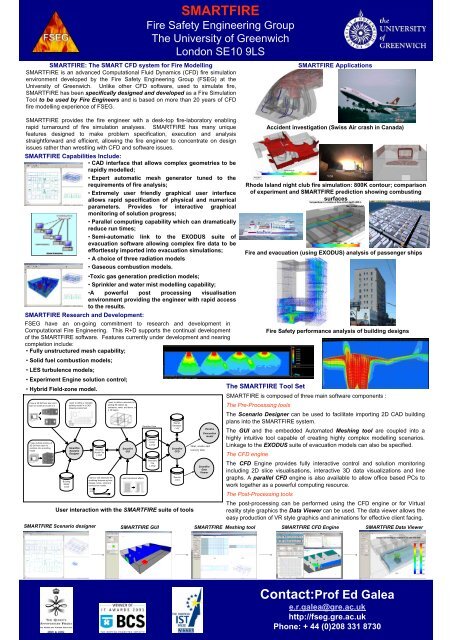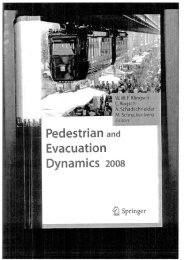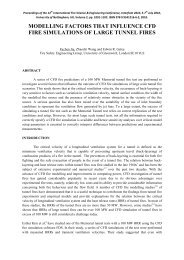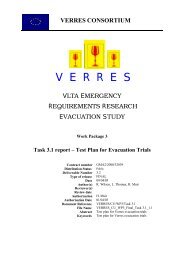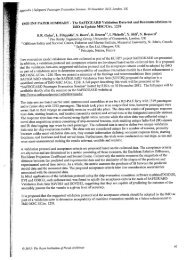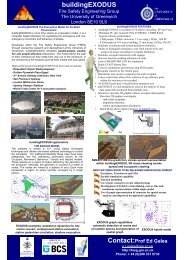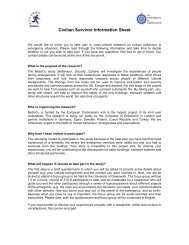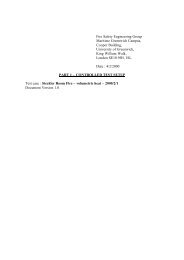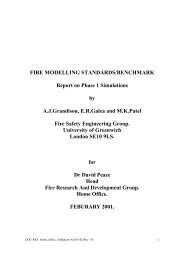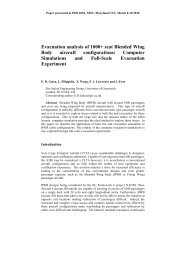SMARTFIRE - Fire Safety Engineering Group - University of Greenwich
SMARTFIRE - Fire Safety Engineering Group - University of Greenwich
SMARTFIRE - Fire Safety Engineering Group - University of Greenwich
You also want an ePaper? Increase the reach of your titles
YUMPU automatically turns print PDFs into web optimized ePapers that Google loves.
<strong>SMARTFIRE</strong><br />
<strong>Fire</strong> <strong>Safety</strong> <strong>Engineering</strong> <strong>Group</strong><br />
The <strong>University</strong> <strong>of</strong> <strong>Greenwich</strong><br />
London SE10 9LS<br />
<strong>SMARTFIRE</strong>: The SMART CFD system for <strong>Fire</strong> Modelling<br />
<strong>SMARTFIRE</strong> is an advanced Computational Fluid Dynamics (CFD) fire simulation<br />
environment developed by the <strong>Fire</strong> <strong>Safety</strong> <strong>Engineering</strong> <strong>Group</strong> (FSEG) at the<br />
<strong>University</strong> <strong>of</strong> <strong>Greenwich</strong>. Unlike other CFD s<strong>of</strong>tware, used to simulate fire,<br />
<strong>SMARTFIRE</strong> has been specifically designed and developed as a <strong>Fire</strong> Simulation<br />
Tool to be used by <strong>Fire</strong> Engineers and is based on more than 20 years <strong>of</strong> CFD<br />
fire modelling experience <strong>of</strong> FSEG.<br />
<strong>SMARTFIRE</strong> provides the fire engineer with a desk-top fire-laboratory enabling<br />
rapid turnaround <strong>of</strong> fire simulation analyses. <strong>SMARTFIRE</strong> has many unique<br />
features designed to make problem specification, execution and analysis<br />
straightforward and efficient, allowing the fire engineer to concentrate on design<br />
issues rather than wrestling with CFD and s<strong>of</strong>tware issues.<br />
<strong>SMARTFIRE</strong> Capabilities Include:<br />
• CAD interface that allows complex geometries to be<br />
rapidly modelled;<br />
• Expert automatic mesh generator tuned to the<br />
requirements <strong>of</strong> fire analysis;<br />
• Extremely user friendly graphical user interface<br />
allows rapid specification <strong>of</strong> physical and numerical<br />
parameters. Provides for interactive graphical<br />
monitoring <strong>of</strong> solution progress;<br />
• Parallel computing capability which can dramatically<br />
reduce run times;<br />
• Semi-automatic link to the EXODUS suite <strong>of</strong><br />
evacuation s<strong>of</strong>tware allowing complex fire data to be<br />
effortlessly imported into evacuation simulations;<br />
• A choice <strong>of</strong> three radiation models<br />
• Gaseous combustion models.<br />
<strong>SMARTFIRE</strong> Applications<br />
Accident investigation (Swiss Air crash in Canada)<br />
Rhode Island night club fire simulation: 800K contour; comparison<br />
<strong>of</strong> experiment and <strong>SMARTFIRE</strong> prediction showing combusting<br />
surfaces<br />
<strong>Fire</strong> and evacuation (using EXODUS) analysis <strong>of</strong> passenger ships<br />
•Toxic gas generation prediction models;<br />
• Sprinkler and water mist modelling capability;<br />
•A powerful post processing visualisation<br />
environment providing the engineer with rapid access<br />
to the results.<br />
<strong>SMARTFIRE</strong> Research and Development:<br />
FSEG have an on-going commitment to research and development in<br />
Computational <strong>Fire</strong> <strong>Engineering</strong>. This R+D supports the continual development<br />
<strong>Fire</strong> <strong>Safety</strong> performance analysis <strong>of</strong> building designs<br />
<strong>of</strong> the <strong>SMARTFIRE</strong> s<strong>of</strong>tware. Features currently under development and nearing<br />
completion include:<br />
• Fully unstructured mesh capability;<br />
• Solid fuel combustion models;<br />
• LES turbulence models;<br />
• Experiment Engine solution control;<br />
• Hybrid Field-zone model.<br />
The <strong>SMARTFIRE</strong> Tool Set<br />
<strong>SMARTFIRE</strong> is composed <strong>of</strong> three main s<strong>of</strong>tware components :<br />
I have a 2D Dxf floor plan and I<br />
I want to define a complex<br />
I want to define a scenario by<br />
want to model all or part <strong>of</strong> it<br />
building model in a CAD<br />
adding 3D objects eg<br />
The Pre-Processing tools<br />
drawing environment<br />
obstacles, vents, and doors, to<br />
a3D region<br />
The Scenario Designer can be used to facilitate importing 2D CAD building<br />
Restart<br />
plans into the <strong>SMARTFIRE</strong> system.<br />
Smartfire Case<br />
Database<br />
[.vts]<br />
Exodus<br />
The GUI and the embedded Automated Meshing tool are coupled into a<br />
Evacuation<br />
model<br />
Command<br />
highly intuitive tool capable <strong>of</strong> creating highly complex modelling scenarios.<br />
I have multiple storeys <strong>of</strong><br />
Script<br />
2D Dxf floor plans to<br />
[.smc]<br />
Heat, smoke and Linkage to the EXODUS suite <strong>of</strong> evacuation models can also be specified.<br />
combine into a building<br />
Smartfire<br />
Smartfire<br />
Smartfire<br />
model<br />
Smartfire<br />
Scenario<br />
toxicity data<br />
Model File<br />
GUI<br />
CFD<br />
Designer<br />
[.smf]<br />
The CFD engine<br />
Geometry<br />
File<br />
The CFD Engine provides fully interactive control and solution monitoring<br />
[.smg]<br />
Smartfire<br />
Data<br />
Viewer including 2D slice visualisations, interactive 3D data visualizations and line<br />
I want to use advanced fire I want transitional effects<br />
Results<br />
[.vtk]<br />
graphs. A parallel CFD engine is also available to allow <strong>of</strong>fice based PCs to<br />
modelling features eg heat<br />
Building<br />
release curves, smoke &<br />
Model<br />
combustion models<br />
[.bld]<br />
work together as a powerful computing resource.<br />
Heat<br />
(kW)<br />
t(s)<br />
The Post-Processing tools<br />
The post-processing can be performed using the CFD engine or for Virtual<br />
User interaction with the <strong>SMARTFIRE</strong> suite <strong>of</strong> tools<br />
reality style graphics the Data Viewer can be used. The data viewer allows the<br />
easy production <strong>of</strong> VR style graphics and animations for effective client facing.<br />
<strong>SMARTFIRE</strong> Scenario designer <strong>SMARTFIRE</strong> GUI <strong>SMARTFIRE</strong> Meshing tool <strong>SMARTFIRE</strong> CFD Engine <strong>SMARTFIRE</strong> Data Viewer<br />
.<br />
Contact:Pr<strong>of</strong> Ed Galea<br />
e.r.galea@gre.ac.uk<br />
http://fseg.gre.ac.uk<br />
Phone: + 44 (0)208 331 8730
<strong>Fire</strong> <strong>Safety</strong> <strong>Engineering</strong> <strong>Group</strong><br />
The <strong>University</strong> <strong>of</strong> <strong>Greenwich</strong><br />
London SE10 9LS<br />
A WORLD LEADER IN COMPUTATIONAL FIRE ENGINEERING<br />
The <strong>Fire</strong> <strong>Safety</strong> <strong>Engineering</strong> <strong>Group</strong> (FSEG) <strong>of</strong> the <strong>University</strong> <strong>of</strong><br />
<strong>Greenwich</strong> was founded by Pr<strong>of</strong> Galea in 1986. The research and<br />
consultancy interests <strong>of</strong> the 30 strong team are focused on the<br />
development and application <strong>of</strong> Computational <strong>Fire</strong> <strong>Engineering</strong><br />
(CFE) tools for the simulation <strong>of</strong> evacuation, non-emergency<br />
circulation <strong>of</strong> people, combustion, fire/smoke spread, structural<br />
response to fire and fire suppression. High pr<strong>of</strong>ile applications <strong>of</strong><br />
FSEG skills and technology in the built environment, aerospace,<br />
marine and rail sectors include:<br />
• 9/11 WTC – evacuation analysis<br />
• Airbus A380 super jumbo - evacuation analysis<br />
• SwissAir MD11 disaster inquiry – fire analysis<br />
• New Royal Navy aircraft carrier (CVF) – evacuation analysis<br />
• Ladbroke Grove rail disaster inquiry – fire/evacuation analysis<br />
•Sydney Olympic Stadium – evacuation analysis<br />
AWARD-WINNING SOFTWARE<br />
Research undertaken by FSEG has lead to the development <strong>of</strong> the<br />
CFE s<strong>of</strong>tware: <strong>SMARTFIRE</strong>, buildingEXODUS, airEXODUS and<br />
maritimeEXODUS. These products are distributed world-wide by<br />
FSEG to customers in 30 countries. FSEG’s innovation has been<br />
recognised through a number <strong>of</strong> prestigious awards:<br />
· SFPE Bono Award 2008<br />
• Royal Aeronautical Society’s Gold Award and George Taylor<br />
Prize 2006,<br />
• IST prize 2004 awarded by the EU and the European Council<br />
<strong>of</strong> Applied Sciences, Technology and <strong>Engineering</strong><br />
· Queen’s Anniversary Prize 2002<br />
· British Computer Society IT Award, 2001<br />
· Royal Institution <strong>of</strong> Naval Architecture/Lloyds Register Safer<br />
Ship Award 2001<br />
· Communications & IT in Shipping Award for Innovation in IT<br />
for Ship Operation 2002<br />
<strong>SMARTFIRE</strong> generated fire and smoke spread in<br />
above ceiling aircraft space<br />
INTERNATIONAL RESEARCH AND CONSULTANCY<br />
FSEG is one <strong>of</strong> Europe's leading centres <strong>of</strong> excellence in CFE. It<br />
is also one <strong>of</strong> the largest university-based groups dedicated to<br />
the modelling <strong>of</strong> fire and related phenomena in the world. FSEG<br />
has published over 200 academic and pr<strong>of</strong>essional publications<br />
on fire and related topics. Since 1991 FSEG has generated over<br />
£6 million worth <strong>of</strong> research and consultancy funding and its<br />
research and consultancy activities have been supported by a<br />
client base including:<br />
EADS, BAe Systems, BA, Buro Happold, BMT, Canary Wharf<br />
Management Ltd., EPSRC, EU, European Space Agency,<br />
Mitsubishi, LPC, MCA, NHS, Arup, RINA, Borealis,<br />
Rockwool, Thales, The <strong>Engineering</strong> Link, MOD, Lloyds<br />
Register, CAA, FAA, FRA, Boeing, NTSB, Bombardier,<br />
Canadian Dept <strong>of</strong> Trans, US Dept <strong>of</strong> Trans, Canadian<br />
Transportation <strong>Safety</strong> Board.<br />
buildingEXODUS: Occupant interaction with fire, smoke<br />
and toxic gases<br />
KNOWLEDGE TRANSFER<br />
Members <strong>of</strong> FSEG are actively involved in the supervision <strong>of</strong> doctoral<br />
and masters level research students concerned with fire safety and<br />
the development and delivery <strong>of</strong> fire safety engineering courses,<br />
including, short courses for industry, MSc by Research and Taught<br />
MSc programmes.<br />
Linked <strong>SMARTFIRE</strong> and buildingEXODUS simulation <strong>of</strong><br />
Rhode Island disco fire incorporating smoke, heat, toxic<br />
and irritant gases.<br />
HELPING SET INTERNATIONAL STANDARDS<br />
FSEG expertise is sought by standards bodies such as the BSI, ISO,<br />
IMO and SFPE and is used to set standards in life safety, fire safety<br />
engineering and the use and validation <strong>of</strong> CFE tools.<br />
maritimeEXODUS: Simulation <strong>of</strong> mustering on a large<br />
passenger ship<br />
Examples <strong>of</strong> FSEG research and consultancy projects include:<br />
· Analysis <strong>of</strong> naval/passenger ship design for evacuation<br />
· <strong>Fire</strong>/smoke analysis for underground stations<br />
· Evacuation analysis <strong>of</strong> high-rise buildings<br />
· <strong>Fire</strong>/evacuation design and certification analyses for aircraft<br />
· Circulation/evacuation analysis for airports and subways<br />
· Analysis <strong>of</strong> evacuation provision for hospitals<br />
· Prediction <strong>of</strong> toxic gas generation resulting from cable fires<br />
· Full-scale and experimental scale evacuation trials in aircraft,<br />
buildings, ship and rail environments.<br />
Evacuation Trials: FSEG conduct evacuation trials in a range <strong>of</strong><br />
environments including hospitals, ships, rail carriages and smoke<br />
filled aircraft cabins in order to collect human performance data<br />
Contact:Pr<strong>of</strong> Ed Galea<br />
e.r.galea@gre.ac.uk<br />
http://fseg.gre.ac.uk<br />
Phone: + 44 (0)208 331 8730


